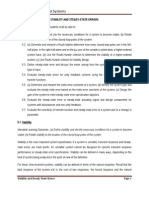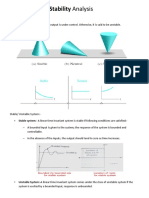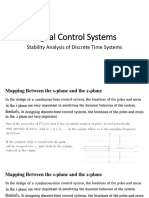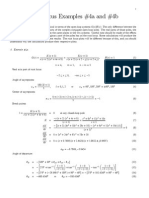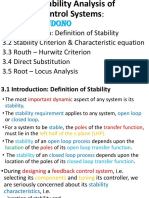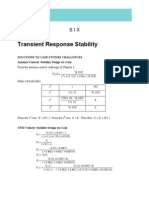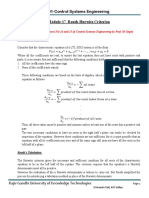Stability-Routh Hurwitz Root Locus
Stability-Routh Hurwitz Root Locus
Uploaded by
AkashCopyright:
Available Formats
Stability-Routh Hurwitz Root Locus
Stability-Routh Hurwitz Root Locus
Uploaded by
AkashOriginal Title
Copyright
Available Formats
Share this document
Did you find this document useful?
Is this content inappropriate?
Copyright:
Available Formats
Stability-Routh Hurwitz Root Locus
Stability-Routh Hurwitz Root Locus
Uploaded by
AkashCopyright:
Available Formats
Control Systems
2024
CONTROL ENGINEERING
Stability-Routh Hurwitz & Root Locus
A VIJAY KUMAR,
Assistant Professor, EEE.
B V Raju Institute of Technology
Narsapur
Department of EEE, BVRIT-Narsapur 1
1. STABILITY
What is Stability?
A system is said to be stable, if its output is under control. Otherwise, it is said
to be unstable. A stable system produces a bounded output for a given
bounded input.
The following figure shows the response of a stable system.
This is the response of first order control system for unit step input. This
response has the values between 0 and 1. So, it is bounded output. We know
that the unit step signal has the value of one for all positive values of t
including zero. So, it is bounded input. Therefore, the first order control system
is stable since both the input and the output are bounded.
Types of Systems based on Stability
We can classify the systems based on stability as follows.
1. Absolutely stable system
2. Conditionally stable system
3. Marginally stable system
Absolutely Stable System
If the system is stable for all the range of system component values, then it is
known as the absolutely stable system. The open loop control system is
absolutely stable if all the poles of the open loop transfer function present in
left half of ‘s’ plane. Similarly, the closed loop control system is absolutely
stable if all the poles of the closed loop transfer function present in the left half
of the ‘s’ plane.
Department of EEE, BVRIT-Narsapur 2
Control Systems
Conditionally Stable System
If the system is stable for a certain range of system component values, then it
is known as conditionally stable system.
Marginally Stable System
If the system is stable by producing an output signal with constant amplitude
and constant frequency of oscillations for bounded input, then it is known as
marginally stable system. The open loop control system is marginally stable if
any two poles of the open loop transfer function is present on the imaginary
axis. Similarly, the closed loop control system is marginally stable if any two
poles of the closed loop transfer function is present on the imaginary axis.
Department of EEE, BVRIT-Narsapur 3
ROUTH-HURWITZ STABILITY CRITERION
Routh-Hurwitz stability criterion is having one necessary condition and one
sufficient condition for stability. If any control system doesn’t satisfy the
necessary condition, then we can say that the control system is unstable. But,
if the control system satisfies the necessary condition, then it may or may not
be stable. So, the sufficient condition is helpful for knowing whether the control
system is stable or not.
Necessary Condition for Routh-Hurwitz Stability
The necessary condition is that the coefficients of the characteristic polynomial
should be positive. This implies that all the roots of the characteristic equation
should have negative real parts.
Consider the characteristic equation of the order ‘n’ is -
Note that, there should not be any term missing in the nth order characteristic
equation. This means that the nth order characteristic equation should not
have any coefficient that is of zero value.
Sufficient Condition for Routh-Hurwitz Stability
The sufficient condition is that all the elements of the first column of the Routh
array should have the same sign. This means that all the elements of the first
column of the Routh array should be either positive or negative.
Routh Array Method
If all the roots of the characteristic equation exist to the left half of the ‘s’ plane,
then the control system is stable. If at least one root of the characteristic
equation exists to the right half of the ‘s’ plane, then the control system is
unstable. So, we have to find the roots of the characteristic equation to know
Department of EEE, BVRIT-Narsapur 4
Control Systems
whether the control system is stable or unstable. But, it is difficult to find the
roots of the characteristic equation as order increases.
So, to overcome this problem there we have the Routh array method. In this
method, there is no need to calculate the roots of the characteristic equation.
First formulate the Routh table and find the number of the sign changes in the
first column of the Routh table. The number of sign changes in the first column
of the Routh table gives the number of roots of characteristic equation that
exist in the right half of the ‘s’ plane and the control system is unstable.
Follow this procedure for forming the Routh table.
1. Fill the first two rows of the Routh array with the coefficients of the
characteristic polynomial as mentioned in the table below. Start with the
coefficient of sn and continue up to the coefficient of s0.
2. Fill the remaining rows of the Routh array with the elements as mentioned
in the table below. Continue this process till you get the first column
element of row s0 is an. Here, an is the coefficient of s0 in the characteristic
polynomial.
Note − If any row elements of the Routh table have some common factor, then
you can divide the row elements with that factor for the simplification will be
easy.
Department of EEE, BVRIT-Narsapur 5
The following table shows the Routh array of the nth order characteristic
polynomial.
Example
Let us find the stability of the control system having characteristic equation,
Step 1 − Verify the necessary condition for the Routh-Hurwitz stability.
All the coefficients of the characteristic polynomial,
are positive. So, the control system satisfies the necessary condition.
Department of EEE, BVRIT-Narsapur 6
Control Systems
Step 2 − Form the Routh array for the given characteristic polynomial.
Step 3 − Verify the sufficient condition for the Routh-Hurwitz stability.
All the elements of the first column of the Routh array are positive. There is no
sign change in the first column of the Routh array. So, the control system is
stable.
Special Cases of Routh Array
We may come across two types of situations, while forming the Routh table. It
is difficult to complete the Routh table from these two situations.
The two special cases are −
1. The first element of any row of the Routh array is zero.
2. All the elements of any row of the Routh array are zero.
Let us now discuss how to overcome the difficulty in these two cases, one by
one.
First Element of any row of the Routh array is zero
If any row of the Routh array contains only the first element as zero and at
least one of the remaining elements have non-zero value, then replace the first
element with a small positive integer, ϵ. And then continue the process of
Department of EEE, BVRIT-Narsapur 7
Control Systems
completing the Routh table. Now, find the number of sign changes in the first
column of the Routh table by substituting ϵ tends to zero.
Example
Let us find the stability of the control system having characteristic equation,
Step 1 − Verify the necessary condition for the Routh-Hurwitz stability.
All the coefficients of the characteristic polynomial,
are positive. So, the control system satisfied the necessary condition.
Step 2 − Form the Routh array for the given characteristic polynomial.
The row s3 elements have 2 as the common factor. So, all these elements are
divided by 2.
Special case (i) − Only the first element of row s2 is zero. So, replace it by ϵ
and continue the process of completing the Routh table.
Department of EEE, BVRIT-Narsapur 8
Control Systems
Step 3 − Verify the sufficient condition for the Routh-Hurwitz stability.
As ϵ tends to zero, the Routh table is.
There are two sign changes in the first column of Routh table. Hence, the control
system is unstable.
All the Elements of any row of the Routh array are zero
In this case, follow these two steps −
1. Write the auxilary equation, A(s) of the row, which is just above the row
of zeros.
2. Differentiate the auxiliary equation, A(s) with respect to s. Fill the row of
zeros with these coefficients.
Department of EEE, BVRIT-Narsapur 9
Control Systems
Example
Let us find the stability of the control system having characteristic equation,
Step 1 − Verify the necessary condition for the Routh-Hurwitz stability.
All the coefficients of the given characteristic polynomial are positive. So, the
control system satisfied the necessary condition.
Step 2 − Form the Routh array for the given characteristic polynomial.
The row s4 elements have the common factor of 3. So, all these elements are
divided by 3.
Special case (ii) − All the elements of row s3 are zero. So, write the auxiliary
equation, A(s) of the row s4
Differentiate the above equation with respect to s.
Place these coefficients in row s3
Department of EEE, BVRIT-Narsapur 10
Control Systems
Step 3 − Verify the sufficient condition for the Routh-Hurwitz stability.
There are two sign changes in the first column of Routh table. Hence, the control
system is unstable.
In the Routh-Hurwitz stability criterion, we can know whether the closed loop
poles are in on left half of the ‘s’ plane or on the right half of the ‘s’ plane or on
an imaginary axis. So, we can’t find the nature of the control system. To
overcome this limitation, there is a technique known as the root locus
Department of EEE, BVRIT-Narsapur 11
ROOT LOCUS
Introduction
The Root locus is the locus of the roots of the characteristic equation by varying
system gain K from zero to infinity.
We know that, the characteristic equation of the closed loop control system is
We can represent G(s)H(s) as
Where,
K represents the multiplying factor
N(s) represents the numerator term having (factored) nth order
polynomial of ‘s’.
D(s) represents the denominator term having (factored) mth order
polynomial of ‘s’.
Substitute, G(s)H(s) value in the characteristic equation.
Case 1 − K = 0
If K=0, then D(s)=0.
Therefore, the closed loop poles are equal to open loop poles when K is
zero.
Case 2 − K = ∞
Re-write the above characteristic equation as
Department of EEE, BVRIT-Narsapur 12
Control Systems
Substitute, K=∞ in the above equation.
If K=∞, then N(s)=0. Therefore, the closed loop poles are equal to the open
loop zeros when K is infinity.
From above two cases, we can conclude that the root locus branches start at
open loop poles and end at open loop zeros.
Angle Condition and Magnitude Condition
The points on the root locus branches satisfy the angle condition. So, the angle
condition is used to know whether the point exist on root locus branch or not.
We can find the value of K for the points on the root locus branches by using
magnitude condition. So, we can use the magnitude condition for the points,
and this satisfies the angle condition.
Characteristic equation of closed loop control system is
The phase angle of G(s)H(s) is
The angle condition is the point at which the angle of the open loop transfer
function is an odd multiple of 1800.
Magnitude of G(s)H(s) is -
The magnitude condition is that the point (which satisfied the angle
condition) at which the magnitude of the open loop transfer function is one.
Department of EEE, BVRIT-Narsapur 13
Control Systems
ROOT LOCUS
The root locus is a graphical representation in s-domain and it is symmetrical
about the real axis. Because the open loop poles and zeros exist in the s-
domain having the values either as real or as complex conjugate pairs. In this
chapter, let us discuss how to construct (draw) the root locus.
Rules for Construction of Root Locus
Follow these rules for constructing a root locus.
Rule 1 − Locate the open loop poles and zeros in the ‘s’ plane.
Rule 2 − Find the number of root locus branches.
We know that the root locus branches start at the open loop poles and end at
open loop zeros. So, the number of root locus branches N is equal to the
number of finite open loop poles P or the number of finite open loop zeros Z,
whichever is greater.
Mathematically, we can write the number of root locus branches N as
N=P
if P≥Z
N=Z
if P<Z
Rule 3 − Identify and draw the real axis root locus branches.
If the angle of the open loop transfer function at a point is an odd multiple of
1800, then that point is on the root locus. If odd number of the open loop poles
and zeros exist to the left side of a point on the real axis, then that point is on
Department of EEE, BVRIT-Narsapur 14
Control Systems
the root locus branch. Therefore, the branch of points which satisfies this
condition is the real axis of the root locus branch.
Rule 4 − Find the centroid and the angle of asymptotes.
If P=Z, then all the root locus branches start at finite open loop poles and
end at finite open loop zeros.
If P>Z, then Z number of root locus branches start at finite open loop
poles and end at finite open loop zeros and P−Z number of root locus
branches start at finite open loop poles and end at infinite open loop
zeros.
If P<Z, then P number of root locus branches start at finite open loop
poles and end at finite open loop zeros and Z−P number of root locus
branches start at infinite open loop poles and end at finite open loop
zeros.
So, some of the root locus branches approach infinity, when P≠Z. Asymptotes
give the direction of these root locus branches. The intersection point of
asymptotes on the real axis is known as centroid.
We can calculate the centroid by using this formula,
The formula for the angle of asymptotes θ is
Where,
q=0,1,2,....,(P−Z)−1
Department of EEE, BVRIT-Narsapur 15
Control Systems
Rule 5 − Find the intersection points of root locus branches with an imaginary
axis.
We can calculate the point at which the root locus branch intersects the
imaginary axis and the value of K at that point by using the Routh array
method and special case (ii).
If all elements of any row of the Routh array are zero, then the root locus
branch intersects the imaginary axis and vice-versa.
Identify the row in such a way that if we make the first element as zero,
then the elements of the entire row are zero. Find the value of K for this
combination.
Substitute this K value in the auxiliary equation. You will get the
intersection point of the root locus branch with an imaginary axis.
Rule 6 − Find Break-away and Break-in points.
If there exists a real axis root locus branch between two open loop poles,
then there will be a break-away point in between these two open loop
poles.
If there exists a real axis root locus branch between two open loop zeros,
then there will be a break-in point in between these two open loop zeros.
Note − Break-away and break-in points exist only on the real axis root locus
branches.
Follow these steps to find break-away and break-in points.
Write K in terms of s from the characteristic equation 1+G(s)H(s)=0.
Differentiate K with respect to s and make it equal to zero. Substitute
these values of s in the above equation.
The values of s for which the K value is positive are the break points.
Rule 7 − Find the angle of departure and the angle of arrival.
Department of EEE, BVRIT-Narsapur 16
Control Systems
The Angle of departure and the angle of arrival can be calculated at complex
conjugate open loop poles and complex conjugate open loop zeros respectively.
The formula for the angle of departure ϕd is
The formula for the angle of arrival ϕa is
Where,
Example
Let us now draw the root locus of the control system having open loop transfer
function, G(s)H(s)=K/s(s+1)(s+5)
Step 1 − The given open loop transfer function has three poles at s=0, −1 and
−5. It doesn’t have any zero. Therefore, the number of root locus branches is
equal to the number of poles of the open loop transfer function.
N=P=3
Department of EEE, BVRIT-Narsapur 17
Control Systems
The three poles are located are shown in the above figure. The line segment
between s=−1 and s=0 is one branch of root locus on real axis. And the other
branch of the root locus on the real axis is the line segment to the left of s=−5.
Step 2 − We will get the values of the centroid and the angle of asymptotes by
using the given formulae.
Centroid =−2
The angle of asymptotes are θ=600, 1800 and 3000.
The centroid and three asymptotes are shown in the following figure.
Step 3 − Since two asymptotes have the angles of 600 and 3000, two root locus
branches intersect the imaginary axis. By using the Routh array method and
special case(ii), the root locus branches intersects the imaginary axis at j–√5
and −j√–5.
There will be one break-away point on the real axis root locus branch between
the poles s=−1 and s=0. By following the procedure given for the calculation of
break-away point, we will get it as s=−0.473.
The root locus diagram for the given control system is shown in the following
figure.
Department of EEE, BVRIT-Narsapur 18
Control Systems
In this way, you can draw the root locus diagram of any control system and
observe the movement of poles of the closed loop transfer function.
From the root locus diagrams, we can know the range of K values for different
types of damping.
Effects of Adding Open Loop Poles and Zeros on Root Locus
The root locus can be shifted in ‘s’ plane by adding the open loop poles and the
open loop zeros.
If we include a pole in the open loop transfer function, then some of root
locus branches will move towards right half of ‘s’ plane. Because of this, the
damping ratio δ decreases. Which implies, damped frequency ωd increases
and the time domain specifications like delay time td, rise time tr and peak
time tp decrease. But, it affects the system stability.
If we include a zero in the open loop transfer function, then some of root
locus branches will move towards left half of ‘s’ plane. So, it will increase the
control system stability. In this case, the damping ratio δ increases. Which
implies, damped frequency ωd decreases and the time domain specifications
like delay time td, rise time tr and peak time tp increase.
So, based on the requirement, we can include (add) the open loop poles or
zeros to the transfer function.
Department of EEE, BVRIT-Narsapur 19
You might also like
- DAVID SMITH - Control Systems For Complete Idiots (Electrical Engineering For Complete Idiots) (2018)Document114 pagesDAVID SMITH - Control Systems For Complete Idiots (Electrical Engineering For Complete Idiots) (2018)OSCAR JAVIER SUAREZ VENTO100% (2)
- What Is Stability?: Stability Analysis in S-DomainDocument19 pagesWhat Is Stability?: Stability Analysis in S-DomainChetan GhatageNo ratings yet
- Lecture 3 StabilityDocument4 pagesLecture 3 Stabilitywaqasiqbal.ccNo ratings yet
- Stability AnalysisDocument7 pagesStability AnalysisYash PednekarNo ratings yet
- Chapter 6Document20 pagesChapter 6Duncan KingNo ratings yet
- 505 - Lec 11 PDFDocument28 pages505 - Lec 11 PDFUdara DissanayakeNo ratings yet
- Stability in Control SystemsDocument20 pagesStability in Control Systemssamir100% (2)
- Chapter Four StabilityDocument65 pagesChapter Four StabilityEmran AbbasNo ratings yet
- StabilityDocument20 pagesStabilityravalNo ratings yet
- Routh-Hurwitz StabilityDocument10 pagesRouth-Hurwitz Stability2021uce0050No ratings yet
- Modules ICSDocument141 pagesModules ICShokohad413No ratings yet
- Chapter+6+-+Stability 03272024Document34 pagesChapter+6+-+Stability 03272024engrkumailabbasNo ratings yet
- Control Systems Unit3 Stability Analysis REVISEDDocument42 pagesControl Systems Unit3 Stability Analysis REVISEDvedaNo ratings yet
- Stability of Linear Control System: Bounded-Input Bounded-Output (BIBO) StabilityDocument9 pagesStability of Linear Control System: Bounded-Input Bounded-Output (BIBO) Stabilitymeseret sisayNo ratings yet
- SME Official Layout Module+10Document20 pagesSME Official Layout Module+10JmbernabeNo ratings yet
- Stability AnalysisDocument14 pagesStability Analysisgayatri jaltareNo ratings yet
- Control System (Unit-3)Document38 pagesControl System (Unit-3)sravaniNo ratings yet
- 1conDocument14 pages1conAli Hussain Ali MahmoudNo ratings yet
- 6 Module 6 Routh Hurwitz CriterionDocument30 pages6 Module 6 Routh Hurwitz CriterionJyotirmayee Panda100% (1)
- Control Systems Lectures-Ch6-MineDocument12 pagesControl Systems Lectures-Ch6-Minebayanalradi2002No ratings yet
- Control Systems (CS) : Lecture-17 Routh-Herwitz Stability CriterionDocument18 pagesControl Systems (CS) : Lecture-17 Routh-Herwitz Stability CriterionAdil KhanNo ratings yet
- Stability: Dr. Issam ELGMATIDocument27 pagesStability: Dr. Issam ELGMATI7moud alajlaniNo ratings yet
- CS II Lab Manual 5Document5 pagesCS II Lab Manual 5Ibtsaam ElahiNo ratings yet
- Control14 Routh - Hurwitz Criterion W Hand Written NoteDocument15 pagesControl14 Routh - Hurwitz Criterion W Hand Written NoteKhong JunYonGNo ratings yet
- Routh-Hurwitz Criterion: Name: Aamir Irshad Section:B SAB NO:70065601 REG NO:BSME-016-047 Assignment No:02Document8 pagesRouth-Hurwitz Criterion: Name: Aamir Irshad Section:B SAB NO:70065601 REG NO:BSME-016-047 Assignment No:02Äâmïř ÌřşhądNo ratings yet
- Routh Hurtwitz CriterionDocument2 pagesRouth Hurtwitz CriterionKeshav JhaNo ratings yet
- Biomedical Control Systems (BCS) : Module Leader: DR Muhammad ArifDocument34 pagesBiomedical Control Systems (BCS) : Module Leader: DR Muhammad ArifJpradha KamalNo ratings yet
- FeedCon (Unit 5) PDFDocument43 pagesFeedCon (Unit 5) PDFAbby MacallaNo ratings yet
- Lecure 3Document23 pagesLecure 3Abusabah I. A. AhmedNo ratings yet
- Routh - Hurwitz - Stability - Part1 V1Document31 pagesRouth - Hurwitz - Stability - Part1 V1Emtiaz UddinNo ratings yet
- Control Systems EENG 315 Quiz 3Document5 pagesControl Systems EENG 315 Quiz 3zghanemNo ratings yet
- FeedCon (Unit 5)Document18 pagesFeedCon (Unit 5)Christelle Cha LotaNo ratings yet
- Control Systems3Document34 pagesControl Systems32. Sarthak RangoleNo ratings yet
- Stability: Sistem Pengendalian Otomatik Departemen Teknik Fisika Ftirs - ItsDocument32 pagesStability: Sistem Pengendalian Otomatik Departemen Teknik Fisika Ftirs - ItsUliya Rifda HanifaNo ratings yet
- Stabilty Routh HurwitzDocument33 pagesStabilty Routh HurwitzAhmad SherNo ratings yet
- Chapter 6 - StabilityDocument19 pagesChapter 6 - StabilityDL ArtsNo ratings yet
- Stability: Term Paper - IPC Made by - Krishna Patel (18BCH045)Document28 pagesStability: Term Paper - IPC Made by - Krishna Patel (18BCH045)PATEL KRISHNANo ratings yet
- 4 - en - MIA - O2.3 - Exp Course 6 - Course Material - Part 4 MPDocument46 pages4 - en - MIA - O2.3 - Exp Course 6 - Course Material - Part 4 MPMaria-Alejandra GUERRERONo ratings yet
- Lecture 4Document19 pagesLecture 4Houssam moussaNo ratings yet
- Chapter 4 Stability AnalysisDocument35 pagesChapter 4 Stability Analysis7014KANISHKA JAISWALNo ratings yet
- Transient & Steady State Response AnalysisDocument32 pagesTransient & Steady State Response AnalysisMisbah Sajid ChaudhryNo ratings yet
- Chapter 5 - System StabilityDocument27 pagesChapter 5 - System StabilityANDREW LEONG CHUN TATT STUDENTNo ratings yet
- Feedback Control Systems (FCS) : Lecture19-20 Routh-Herwitz Stability CriterionDocument24 pagesFeedback Control Systems (FCS) : Lecture19-20 Routh-Herwitz Stability CriterionRajNo ratings yet
- Lecture 380-14 - RHDocument29 pagesLecture 380-14 - RH- FBANo ratings yet
- Regulation and Control: by Tewedage SileshiDocument22 pagesRegulation and Control: by Tewedage SileshihermelaNo ratings yet
- Lec 5Document33 pagesLec 5kokamahmoud902No ratings yet
- Routh-Hurwitz Stability CriterionDocument33 pagesRouth-Hurwitz Stability CriterionFarhan d'Avenger0% (1)
- Feedback Control Systems (FCS) : Lecture-26 Routh-Herwitz Stability CriterionDocument19 pagesFeedback Control Systems (FCS) : Lecture-26 Routh-Herwitz Stability CriterionSARTHAK BAPATNo ratings yet
- Transient and Steady State Response Analysis 2Document37 pagesTransient and Steady State Response Analysis 2ikhlasahmedsadikikhNo ratings yet
- Lecture 7-StabiltyZEFDocument38 pagesLecture 7-StabiltyZEFywtmecaffggweyrmqxNo ratings yet
- Control Systems Theory: Transient Response Stability STB 35103Document68 pagesControl Systems Theory: Transient Response Stability STB 35103Muhammad Irvan FNo ratings yet
- Experiment No 1 Analysis of Control System ParametersDocument6 pagesExperiment No 1 Analysis of Control System Parameterspratik KumarNo ratings yet
- Digital Control Systems: Stability Analysis of Discrete Time SystemsDocument33 pagesDigital Control Systems: Stability Analysis of Discrete Time SystemsRohan100% (1)
- Control Systems Engineering: StabilityDocument30 pagesControl Systems Engineering: StabilityEren ÖzataNo ratings yet
- Unit-4 Concept of Stability Part-1: Priya Mohad Assistant Professor BIHER, ChennaiDocument25 pagesUnit-4 Concept of Stability Part-1: Priya Mohad Assistant Professor BIHER, ChennaiSANDEEP CHOWDARYNo ratings yet
- Routh HurwitzDocument14 pagesRouth HurwitzVipul SinghalNo ratings yet
- 18-Stability Analysis - Routh Array and Root Locus Method-07!03!2024Document16 pages18-Stability Analysis - Routh Array and Root Locus Method-07!03!2024yadavpravin5151No ratings yet
- Control Systems UNIT 3 Stability Analysis: Ripal PatelDocument42 pagesControl Systems UNIT 3 Stability Analysis: Ripal PatelPulkit SinghNo ratings yet
- Stability Analysis-Control SystemDocument29 pagesStability Analysis-Control SystemNanmaran Rajendiran100% (1)
- 1 Stability-Analysis (Important)Document33 pages1 Stability-Analysis (Important)Tahmid ShihabNo ratings yet
- Root Locus ExamplesDocument5 pagesRoot Locus Examplesahmed s. Nour100% (1)
- Topic 3.0 Stability Analysis of FB Controlsystems TCE 5102Document30 pagesTopic 3.0 Stability Analysis of FB Controlsystems TCE 5102princekamutikanjoreNo ratings yet
- Transient Response Stability: Solutions To Case Studies Challenges Antenna Control: Stability Design Via GainDocument43 pagesTransient Response Stability: Solutions To Case Studies Challenges Antenna Control: Stability Design Via Gain오유택No ratings yet
- CS 2255 Control Systems Question BankDocument62 pagesCS 2255 Control Systems Question BankreporterrajiniNo ratings yet
- Chapter 10 - Stability of Closed-Loop Control SystemsDocument27 pagesChapter 10 - Stability of Closed-Loop Control SystemsFakhrulShahrilEzanieNo ratings yet
- Routh-Hurwitz Criterion: Special Cases: 1) Zero Only in The First ColumnDocument12 pagesRouth-Hurwitz Criterion: Special Cases: 1) Zero Only in The First ColumnMohamed KadhimNo ratings yet
- Chapter 3 - Stability of Control SystemDocument99 pagesChapter 3 - Stability of Control SystemTân NguyễnNo ratings yet
- Nptel Jan2019 A4 SolDocument5 pagesNptel Jan2019 A4 SolNeeraj GuptaNo ratings yet
- Block Diagram of A Control System: 11 August 2021 12:48Document68 pagesBlock Diagram of A Control System: 11 August 2021 12:48TUSHIT JHANo ratings yet
- Routh Hurwitz Stability Criteria - GATE Study Material in PDFDocument7 pagesRouth Hurwitz Stability Criteria - GATE Study Material in PDFPraveen AgrawalNo ratings yet
- Chapter 5 - StabilityDocument14 pagesChapter 5 - StabilityMustafa ManapNo ratings yet
- EE 312 Lecture 6Document9 pagesEE 312 Lecture 6دكتور كونوهاNo ratings yet
- JNTUA Control Systems Engineering PPT Notes - R20Document142 pagesJNTUA Control Systems Engineering PPT Notes - R20varasiddi510No ratings yet
- Stability PDFDocument64 pagesStability PDFGlan DevadhasNo ratings yet
- Control SystemsDocument161 pagesControl SystemsDr. Gollapalli NareshNo ratings yet
- 351 - 27435 - EE419 - 2020 - 1 - 2 - 1 - 14 EE419 Lec14 Jury StabilityDocument39 pages351 - 27435 - EE419 - 2020 - 1 - 2 - 1 - 14 EE419 Lec14 Jury Stabilityyoussef hossamNo ratings yet
- Unit 5: Stability: Engineering 5821: Control Systems IDocument18 pagesUnit 5: Stability: Engineering 5821: Control Systems INikhil PanikkarNo ratings yet
- Ec8391-Control Systems Engineering-947551245-Cse QBDocument18 pagesEc8391-Control Systems Engineering-947551245-Cse QBMr. V. Buvanesh Pandian EIE-2019-A SEC BATCHNo ratings yet
- IPC Term Paper: Presented By: Samriddha Das Gupta (18BCH055)Document28 pagesIPC Term Paper: Presented By: Samriddha Das Gupta (18BCH055)Samriddha Das GuptaNo ratings yet
- Worksheet 4Document3 pagesWorksheet 4oqmbzhcpdizkbctqrhNo ratings yet
- Control Instrumentation LabDocument57 pagesControl Instrumentation LabgeethaNo ratings yet
- Lecture 7 & 8 (Stability Analysis)Document35 pagesLecture 7 & 8 (Stability Analysis)muhammad hamzaNo ratings yet
- Stability TestDocument28 pagesStability TestjobertNo ratings yet
- 6 Stability of Discrete-Time Systems - CompleteDocument40 pages6 Stability of Discrete-Time Systems - CompleteIvan IndirsyahNo ratings yet
- Module-17 - Routh-Hurwitz Criterion: EE3101-Control Systems EngineeringDocument8 pagesModule-17 - Routh-Hurwitz Criterion: EE3101-Control Systems EngineeringhariNo ratings yet
- Extension of Routh-Hurwitz CriterionDocument37 pagesExtension of Routh-Hurwitz CriterionAunisaliNo ratings yet
- IC8451-2M - by WWW - EasyEngineering.net 1 PDFDocument12 pagesIC8451-2M - by WWW - EasyEngineering.net 1 PDFSuryaNo ratings yet
- EET404 Lect 5 CEDocument8 pagesEET404 Lect 5 CEonesmus wambuaNo ratings yet



























